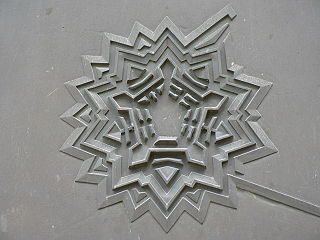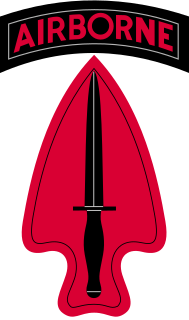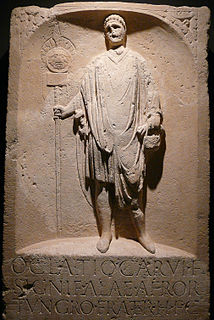 |
| Part of a series on the |
| Military of ancient Rome |
|---|
A discens (Latin : discens, -entis ) was a soldier of the military of ancient Rome who was in training to become an immunis, or specialist within the army.
Latin declension is the set of patterns according to which Latin words are declined, or have their endings altered to show grammatical case and gender. Nouns, pronouns, and adjectives are declined, and a given pattern is called a declension. There are five declensions, which are numbered and grouped by ending and grammatical gender. For simple declension paradigms, visit the Wiktionary appendices: first declension, second declension, third declension, fourth declension, fifth declension. Each noun follows one of the five declensions, but some irregular nouns have exceptions.
The military of ancient Rome, according to Titus Livius, one of the more illustrious historians of Rome over the centuries, was a key element in the rise of Rome over “above seven hundred years” from a small settlement in Latium to the capital of an empire governing a wide region around the shores of the Mediterranean, or, as the Romans themselves said, ‘’mare nostrum’’, “our sea.” Livy asserts
The immunes were Ancient Roman soldiers who possessed specialized skills. They were exempt from the more tedious and dangerous tasks other soldiers were required to do, such as ditch digging and rampart patrol.
Immunes took up the trades and skills of engineers, field medics, carpenters, and craftsmen. However, they were also fully trained and would be expected to fight in the infantry or cavalry if necessary. The discentes were probably exempted, like the immunes, from standard combat and camp duties since their main occupation would have been time-consuming technical training.

An artisan is a skilled craft worker who makes or creates things by hand that may be functional or strictly decorative, for example furniture, decorative arts, sculptures, clothing, jewellery, food items, household items and tools or even mechanisms such as the handmade clockwork movement of a watchmaker. Artisans practice a craft and may through experience and aptitude reach the expressive levels of an artist.

Infantry is the branch of an army that engages in military combat on foot, distinguished from cavalry, artillery, and tank forces. Also known as foot soldiers, infantry traditionally relies on moving by foot between combats as well, but may also use mounts, military vehicles, or other transport. Infantry make up a large portion of all armed forces in most nations, and typically bear the largest brunt in warfare, as measured by casualties, deprivation, or physical and psychological stress.

Cavalry or horsemen are soldiers or warriors who fight mounted on horseback. Cavalry were historically the most mobile of the combat arms. An individual soldier in the cavalry is known by a number of designations such as cavalryman, horseman, dragoon, or trooper. The designation of cavalry was not usually given to any military forces that used other animals, such as camels, mules or elephants. Infantry who moved on horseback, but dismounted to fight on foot, were known in the 17th and early 18th centuries as dragoons, a class of mounted infantry which later evolved into cavalry proper while retaining their historic title.
Some known classes include:
- Discens Architecti - Trainee engineer or artillerist.
- Discens Armaturae - Trainee weapons instructor.
- Discens Aquiliferum (or Aquiliferorum) - Trainee eagle standard-bearer.
- Discens Bucinatorem - Trainee trumpeter.
- Discens Capsariorum - Trainee medical orderly.
- Discens Epibatae - Trainee marine.
- Discens Equitum - Trainee cavalryman.
- Discens Lanchiariorum - Trainee javelin-thrower.
- Discens Mensorem - Trainee surveyor.
- Discens Phalangarium - A soldier training as a phalangarius during the 3rd century AD several experiments were conducted with Macedonian phalanx tactics, apparently requiring special training in weapons handling and drill.
- Discens Signiferorum (or discentes signiferorum) - Trainee standard-bearer.











